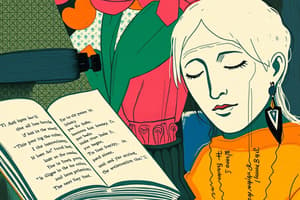Podcast
Questions and Answers
How do figures of speech function in poetry, and why are they significant?
How do figures of speech function in poetry, and why are they significant?
Figures of speech function to create imagery and convey emotions, making the language more evocative and layered in meaning.
What distinguishes a sonnet from a free verse poem?
What distinguishes a sonnet from a free verse poem?
A sonnet is a 14-line poem with specific rhyme schemes and structures, while free verse does not adhere to these traditional forms.
In what ways can poetry explore themes of the human condition?
In what ways can poetry explore themes of the human condition?
Poetry can explore the human condition through personal narratives, emotional expression, and reflection on societal issues.
Explain the role of meter in poetry and its effect on a poem's rhythm.
Explain the role of meter in poetry and its effect on a poem's rhythm.
Describe the characteristics and purpose of narrative poems.
Describe the characteristics and purpose of narrative poems.
How did the evolution of poetic traditions impact modern poetry?
How did the evolution of poetic traditions impact modern poetry?
Why is imagery considered an essential element of poetry?
Why is imagery considered an essential element of poetry?
What is the significance of rhyme in poetry, and how does it affect meaning?
What is the significance of rhyme in poetry, and how does it affect meaning?
Flashcards
What is poetry?
What is poetry?
A form of literary art that uses language's aesthetic and rhythmic features (like sound symbolism, rhythm, and meter) to create meaning beyond literal word meanings.
Figurative Language in Poetry
Figurative Language in Poetry
Poetry often includes metaphors, similes, personification, and hyperbole to build vivid pictures and express feelings.
Forms of Poetry
Forms of Poetry
Poetry comes in different styles like sonnets, haikus, free verse, and ballads, each with its own rules.
Common Themes in Poetry
Common Themes in Poetry
Signup and view all the flashcards
Epic Poems
Epic Poems
Signup and view all the flashcards
Lyric Poems
Lyric Poems
Signup and view all the flashcards
Narrative Poems
Narrative Poems
Signup and view all the flashcards
Imagery in Poetry
Imagery in Poetry
Signup and view all the flashcards
Study Notes
Definition and Characteristics
- Poetry is a form of literary art that uses aesthetic and rhythmic qualities of language—such as phonaesthetic effects, sound symbolism, and metre—to evoke meanings in addition to, or in place of, the literal meaning of the words.
- Poetry typically uses figures of speech such as metaphors, similes, personification, and hyperbole to create imagery and convey emotions.
- It often employs specific structures and forms, such as sonnets, haikus, free verse, and ballads, each with its own conventions and rules.
- Poetry frequently explores themes of love, loss, nature, society, and the human condition.
- Poetry can be written in verse or free verse, with line breaks and stanzas that contribute to the poem's overall effect.
History of Poetry
- Poetry has existed in various forms across cultures and time periods.
- Ancient forms of poetry include epic poems, hymns, and ballads, often passed down orally.
- Different poetic traditions have evolved, including the classical poetry of Greece and Rome, the lyrical poetry of the Romantic era, and the modern and contemporary movements.
- Key figures in the history of poetry have influenced its development and evolution.
Types of Poetry
- Epic poems: Long narrative poems that celebrate heroic deeds and events.
- Lyric poems: Short poems expressing personal emotions and feelings.
- Narrative poems: Poems that tell a story, often including elements of plot, characters, and setting.
- Dramatic poems: Poems that present a scene or dialogue between characters, often mimicking a play.
- Sonnets: 14-line poems with specific rhyme schemes and structures.
- Haiku: A traditional Japanese form of poetry with a specific syllable count per line.
- Free verse: Poetry that does not adhere to traditional rhyme schemes or structures.
- Ballads: Narrative poems that tell a story, often with a musical quality and often focusing on a dramatic event.
Elements of Poetry
- Imagery: Descriptive language that appeals to the senses.
- Figurative language: Language that uses figures of speech to create meaning beyond the literal.
- Meter: The rhythmic pattern of stressed and unstressed syllables in a line of poetry.
- Rhyme: The repetition of similar sounds at the end of lines of poetry.
- Tone: The attitude or feeling expressed by the poem.
Poetic Devices
- Metaphor: A comparison between two unlike things without using "like" or "as."
- Simile: A comparison between two unlike things using "like" or "as."
- Personification: Giving human qualities to non-human things.
- Alliteration: Repetition of consonant sounds at the beginning of words.
- Assonance: Repetition of vowel sounds within words.
- Consonance: Repetition of consonant sounds within words.
- Onomatopoeia: Words that imitate sounds.
- Hyperbole: Extreme exaggeration.
Studying That Suits You
Use AI to generate personalized quizzes and flashcards to suit your learning preferences.



